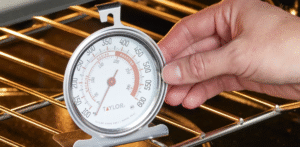
The Complete Guide to Accurate Oven Temperature Control

The Complete Guide to Accurate Oven Temperature Control
Research shows that 80% of home ovens exhibit temperature inaccuracies of 25-50°F, with some deviating up to 75°F from their set point. This comprehensive guide provides professional-level solutions for testing, diagnosing, and correcting these critical temperature discrepancies that can ruin your cooking results.
Temperature inaccuracy in home ovens is surprisingly widespread. Approximately 80% of home ovens exhibit some degree of temperature variance beyond acceptable limits. Most ovens are off their set point by about 25-50°F, which can dramatically impact cooking results. When your oven is set to 325°F but actually running at 360°F, recipes requiring precise temperature control will consistently fail.
It’s crucial to understand that some temperature fluctuation is normal during oven operation. Temperature swings of approximately 25°F are typical during the preheating cycle as heating elements cycle on and off. However, when the average temperature consistently differs from the set point by more than 15-35°F, calibration becomes necessary.
The most reliable method for testing oven temperature accuracy involves using a high-quality standalone oven thermometer. This simple yet effective tool provides real-time temperature readings independent of your oven’s internal sensors.
For comprehensive testing, professional technicians use multiple thermometers placed in different oven zones to map temperature distribution. This method reveals hot and cold spots while confirming overall temperature accuracy. Place three thermometers at different rack positions and compare readings after a 30-minute stabilization period.
Modern digital ovens typically include built-in calibration functions accessible through specific button sequences. These procedures vary by manufacturer but follow similar principles.
After digital calibration, conduct verification tests using the standalone thermometer method. Test at multiple temperatures to ensure the calibration correction applies consistently across the entire temperature range. Some ovens may require fine-tuning adjustments.
Older mechanical ovens use analog thermostats with physical calibration screws requiring manual adjustment. This process requires careful attention and small incremental changes.
The thermostat calibration screw is typically located behind the temperature control knob. Remove the control knob by pulling it straight off the shaft, revealing the calibration screw beneath or adjacent to the shaft.
Always disconnect power to the oven before accessing internal components. Gas ovens require additional safety precautions—shut off the gas supply at the appliance shutoff valve and ensure adequate ventilation during the adjustment process.
The oven temperature sensor, appearing as a protruding metal tube typically located in the upper rear of the oven cavity, plays a crucial role in temperature regulation. This component measures internal oven temperature and communicates with the control board to cycle heating elements appropriately.
A faulty temperature sensor often causes erratic temperature control, error codes, or complete heating failure. Testing sensor resistance provides definitive diagnosis.
Modern ovens use cycling heating elements to maintain set temperatures, resulting in normal temperature fluctuations of approximately 25°F above and below the set point. These swings occur as heating elements turn on and off to maintain temperature. During preheating, temperature swings may be more pronounced as the oven rapidly heats toward the target temperature. Once stabilized, well-functioning ovens maintain temperatures within 15-20°F of the set point most of the time.
Several factors influence oven temperature stability:
Certain oven temperature issues require professional diagnosis and repair:
Professional technicians have specialized equipment including calibrated temperature measurement devices, gas pressure testing tools, and component testing equipment not available to consumers.
Modern oven control boards manage multiple functions including temperature regulation, timing, and safety systems. When control boards fail, temperature accuracy often suffers. Signs of control board failure include inability to enter or save calibration settings, erratic temperature readings, multiple system failures, and intermittent operation.
Maintaining oven temperature accuracy requires ongoing attention:
Kitchen environmental conditions affect oven performance:
Oven temperature inaccuracy affects cooking results more than most home cooks realize. Regular testing using standalone thermometers, proper calibration techniques, and understanding normal temperature variations ensure consistent cooking performance.
Key takeaways for maintaining oven temperature accuracy:
By implementing these testing and calibration procedures, home cooks can achieve professional-level temperature accuracy, ensuring consistent results for everything from delicate pastries to perfectly roasted meats. Regular maintenance and monitoring prevent minor temperature discrepancies from becoming major cooking problems.
Test your oven’s temperature accuracy monthly using a standalone oven thermometer. Place the thermometer in the center of the middle rack, set the oven to 350°F, and allow 20-30 minutes for stabilization before reading. This regular testing helps identify temperature drift before it significantly affects cooking results.
If your oven thermometer shows a reading that is above or below the set temperature by 15 degrees or more, you need to calibrate your oven. Small variations of 10-15 degrees are typically acceptable, but larger discrepancies will significantly impact cooking and baking results.
Yes, you can test your temperature sensor using a multimeter. At room temperature, the sensor should read approximately 1,080 ohms. Disconnect power to the oven, locate the sensor in the oven cavity, disconnect its wiring harness, and test resistance across the sensor terminals. Readings outside 970-1,190 ohms indicate sensor failure.
Temperature swings of approximately 25°F above and below the set point are normal as heating elements cycle on and off to maintain temperature. This cycling is how ovens regulate temperature, similar to how a home thermostat works. However, if fluctuations exceed 35°F or the average temperature differs significantly from the set point, calibration may be needed.
For professional appliance parts and expert repair solutions, check us out for more at OneSourceApplianceParts.com
Last Updated: September 7, 2025 | Professional Content Verified
